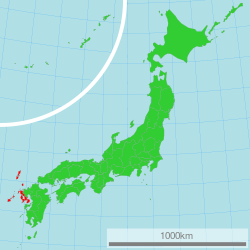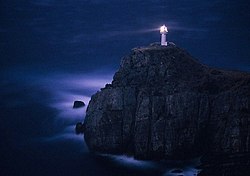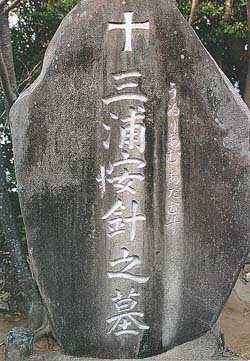Nagasaki Prefecture
 From Wikipedia - Reading time: 12 min
From Wikipedia - Reading time: 12 min
Nagasaki Prefecture
長崎県 | |
|---|---|
| Japanese transcription(s) | |
| • Japanese | 長崎県 |
| • Rōmaji | Nagasaki-ken |
 Obon Festival with tōrō nagashi lantern release on the Albuquerque Bridge over the Sasebo River, Sasebo City, Nagasaki Prefecture | |
| Anthem: Minami no kaze | |
 | |
| Coordinates: 32°45′00″N 129°52′03″E / 32.75000°N 129.86750°E | |
| Country | |
| Region | Kyushu |
| Island | Kyushu |
| Capital | Nagasaki |
| Subdivisions | Districts: 4, Municipalities: 21 |
| Government | |
| • Governor | Kengo Oishi since 2 March 2022 |
| Area | |
• Total | 4,130.88 km2 (1,594.94 sq mi) |
| • Rank | 27th |
| Population (February 1, 2025) | |
• Total | 1,246,481 |
| • Rank | 30th |
| • Density | 302/km2 (780/sq mi) |
| • Dialects | Nagasaki・Tsushima |
| GDP | |
| • Total | JP¥4,800 billion US$43.9 billion (2019) |
| ISO 3166 code | JP-42 |
| Website | www |
| Symbols of Japan | |
| Bird | Mandarin duck (Aix galericulata) |
| Flower | Unzentsutsuji (Rhododendron serpyllifolium) |
| Tree | Sawara (Chamaecyparis pisifera) |
Nagasaki Prefecture (長崎県, Nagasaki-ken[a]) is a prefecture of Japan, mainly located on the island of Kyūshū, although it also includes a number of islands off Kyūshū's northwest coast - including Tsushima and Iki. Nagasaki Prefecture has a population of 1,246,481 (1 February 2025) and has a geographic area of 4,130 km2 (1,594 sq mi). Nagasaki Prefecture borders Saga Prefecture to the northeast.
Nagasaki is the capital and largest city of Nagasaki Prefecture, with other major cities including Sasebo, Isahaya, and Ōmura. Nagasaki Prefecture is located in western Kyūshū with a territory consisting of many mainland peninsulas centered around Ōmura Bay, as well as islands and archipelagos including Tsushima and Iki in the Korea Strait and the Gotō Islands in the East China Sea. Nagasaki Prefecture is known for its century-long trading history with the Europeans and as the sole place of direct trade and exchange between Japan and the outside world during the Sakoku period. Nagasaki Prefecture is home to several of the Hidden Christian Sites in the Nagasaki Region which have been declared a UNESCO World Heritage Site.
History
[edit]Nagasaki Prefecture was created by merging of the western half of the former province of Hizen with the island provinces of Tsushima and Iki.[3] Facing China and Korea, the region around Hirado was a traditional center for traders and pirates.

During the 16th century, Catholic missionaries and traders from Portugal arrived and became active in Hirado and Nagasaki, which became a major center for foreign trade. After being given free rein in Oda Nobunaga's period, the missionaries were forced out little by little, until finally, in the Tokugawa era, Christianity was banned under the Sakoku national isolation policy: Japanese foreign trade was restricted to Chinese and Dutch traders based at Dejima in Nagasaki. However, Kirishitan (Japanese Christian) worship continued underground. These Kakure Kirishitan (hidden Christians) were tried at every step, forced to step on fumi-e ("trample pictures", images of the Virgin Mary and saints) to prove that they were non-Christian. With the banishment of all Catholic missionaries, traders from Catholic countries were also forced out of the country. Along with them, their children, half Japanese and half European, were forced to leave. The majority was sent to Jagatara (Jakarta) and are still remembered by the locals as the people who wrote the poignant letters which were smuggled across the sea to their homeland.
Today, Nagasaki has prominent Catholic churches, and the Hidden Christian Sites in the Nagasaki Region, have been included on the UNESCO World Heritage List.

During the Meiji Restoration, Nagasaki and Sasebo became major ports for foreign trade, and eventually major military bases and shipbuilding centers for the Imperial Japanese Navy and the Mitsubishi Heavy Industries up to World War II. On August 9, 1945, the United States dropped an atomic bomb on Nagasaki, which destroyed all buildings in a 1.6-kilometre (1.0 mi) radius from the point of impact and extensively damaged other parts of the city. Roughly 39,000 people were killed, including 27,778 Japanese munitions workers, 2,000 Korean forced workers, and 150 Japanese soldiers. About 68–80% of the industrial production was destroyed to the point it would not recover for months or at least a year.

Nagasaki Prefecture contains many areas prone to heavy rain and subsequent landslide damage. In July 1957, mainly in the Isahaya area, damage from heavy rains, flooding and landslides lead to a death toll of 586, with 136 people missing and 3,860 injured. In July 1982, typhoon damage in the Nagasaki area lead to 299 fatalities, according to a report by the Japanese government.[citation needed]
Geography
[edit]Nagasaki borders Saga Prefecture on the east, and is otherwise surrounded by water, including Ariake Bay, the Tsushima Straits (far from Busan and South Gyeongsang Province, South Korea), and the East China Sea. It also includes a large number of islands such as Tsushima, Iki and Goto. Most of the prefecture is near the coast and there are a number of ports such as Nagasaki and a United States Navy base at Sasebo.
As of 1 April 2014, 18% of the total land area of the prefecture was designated as Natural Parks, namely the Saikai and Unzen-Amakusa National Parks; Genkai and Iki-Tsushima Quasi-National Parks; and Hokushō, Nishi Sonogi Hantō, Nomo Hantō, Ōmurawan, Shimabara Hantō, and Taradake Prefectural Natural Parks.[4]
Cities
[edit]
City Town



Thirteen cities are located in Nagasaki Prefecture:
| Name | Area (km2) | Population | Map | |
|---|---|---|---|---|
| Rōmaji | Kanji | |||
| 五島市 | 420.81 | 37,775 | 
| |
| 平戸市 | 235.63 | 31,192 | 
| |
| 壱岐市 | 138.57 | 28,008 | ||
| 諫早市 | 341.79 | 135,546 | 
| |
| 松浦市 | 130.37 | 23,566 | ||
| 南島原市 | 169.89 | 45,465 | 
| |
| 長崎市 | 240.71 | 407,624 | ||
| 大村市 | 126.34 | 95,146 | 
| |
| 西海市 | 242.01 | 28,815 | ||
| 佐世保市 | 426.06 | 247,739 | 
| |
| 島原市 | 82.77 | 44,936 | 
| |
| 対馬市 | 708.61 | 31,550 | ||
| 雲仙市 | 206.92 | 42,457 | 
| |
Districts
[edit]These are the towns and villages of each district:
| Name | Area (km2) | Population | District | Type | Map | |
|---|---|---|---|---|---|---|
| Rōmaji | Kanji | |||||
| 波佐見町 | 56 | 14,940 | Higashisonogi District | Town | 
| |
| 東彼杵町 | 74.29 | 8,175 | Higashisonogi District | Town | 
| |
| 川棚町 | 74.25 | 9,219 | Higashisonogi District | Town | 
| |
| 長与町 | 28.81 | 42,570 | Nishisonogi District | Town | 
| |
| 小値賀町 | 25.46 | 2,588 | Kitamatsuura District | Town | 
| |
| 佐々町 | 32.3 | 13,825 | Kitamatsuura District | Town | 
| |
| 新上五島町 | 213.98 | 19,886 | Minami-Matsuura District | Town | 
| |
| 時津町 | 20.73 | 30,084 | Nishisonogi District | Town | 
| |
Mergers
[edit]The following municipalities have been dissolved since the year 2000.
- Kitamatsuura District:
- Minamimatsuura District:
- Nishisonogi District:
- Kitatakaki District:
- Minamitakaki District:
- Kamiagata District:
- Shimoagata District:
- Iki District:
Culture
[edit]Religion
[edit]- Pure Land Buddhism (19.5%)
- Zen Buddhism (3.60%)
- Tendai or Shingon Buddhism (4.90%)
- Soka Gakkai (3.00%)
- Nichiren Buddhism (5.10%)
- Other Buddhist schools (3.00%)
- Christianity (5.10%)
- Shinto sects (2.00%)
- Folk Shinto or no religion (53.8%)
Nagasaki is the most Christianized area in Japan with Roman Catholic missions having been established there as early as the 16th century. Shusaku Endo's novel Silence draws from the oral history of the local Christian (Kirishitan) communities, both Kakure Kirishitan and Hanare Kirishitan.
As of 2002, there are 68,617 Catholics in Nagasaki Prefecture, accounting for 4.52 percent of the population of the prefecture.
Sports
[edit]
The city has one football team, V-Varen Nagasaki, which plays in the J2 League.
The Nagasaki Saints of the former Shikoku-Kyūshū Island League made Nagasaki Prefecture their home prior to their dissolving.
Visitor attractions
[edit]




- Nagasaki (capital city)
- Hirado
- Hirado Castle
- Sakikata Park
- Sasebo
- Saikai
- Nagasaki Bio Park
- Shimabara Peninsula
Transportation
[edit]Rail
[edit]Tram
[edit]Roads
[edit]Expressways and toll roads
[edit]- Kawahira Toll Road
- Kunimi Toll Road
- Nagasaki Dejima Road
- Nagasaki Expressway
- Nishi-Kyūshū Expressway
National highways
[edit]- Route 34
- Route 35
- Route 57
- Route 202
- Route 204
- Route 205
- Route 206
- Route 207
- Route 251
- Route 324
- Route 382
- Route 383
- Route 384
- Route 389
- Route 444
- Route 498
- Route 499
Ports
[edit]- Fukue Port
- Gonoura Port of Iki Island
- Hirado Port
- Izuhara Port of Tsushima
- Matsuura Port
- Nagasaki Port
- Sasebo Port
- Shimabara Port
Airports
[edit]Politics
[edit]The current governor of Nagasaki is Kengo Oishi, who defeated three-term incumbent Hōdō Nakamura in 2022. Oishi, a doctor, was 39 years old when he took office, and the youngest sitting prefectural governor in Japan.[6] Nakamura was first elected in 2010 to succeed Genjirō Kaneko and was previously a vice-governor.
The Nagasaki Prefectural Assembly has a regular membership of 46, elected in 16 electoral districts in unified regional elections (last round: 2011). As of April 2014, the LDP-led caucus has 23 members, the DPJ-SDP-led caucus 17.
In the National Diet, Nagasaki is represented by four directly elected members of the House of Representatives and two (one per ordinary election) of the House of Councillors. After the most recent national elections of 2010, 2012 and 2013, Nagasaki sends an all-LDP delegation to the Diet (excluding members who lost election in Nagasaki districts, but were elected to the proportional representation segment of the House of Representatives in the Kyūshū block).
Notes
[edit]- ^ Japanese pronunciation: [na.ɡaꜜ.sa.kʲi, na.ŋaꜜ-, -ɡa.sa.kʲi̥ꜜ.keɴ, -saꜜ.kʲi̥.keɴ, na.ŋa-][2]
Citations
[edit]- ^ "2020年度国民経済計算(2015年基準・2008SNA) : 経済社会総合研究所 - 内閣府". 内閣府ホームページ (in Japanese). Retrieved 2023-05-18.
- ^ NHK Broadcasting Culture Research Institute, ed. (24 May 2016). NHK日本語発音アクセント新辞典 (in Japanese). NHK Publishing.
- ^ Nussbaum, "Provinces and prefectures" in Japan Encyclopedia, p. 780, at Google Books.
- ^ "General overview of area figures for Natural Parks by prefecture" (PDF). Ministry of the Environment. 1 April 2014. Retrieved 8 February 2015.
- ^ Religion in Japan by prefecture, 1996. English language bar table.
- ^ "Incumbent defeated in Nagasaki governor election". The Japan Times. Retrieved 21 December 2022.
General references
[edit]- Nussbaum, Louis-Frédéric and Käthe Roth (2005). Japan Encyclopedia. Cambridge: Harvard University Press. ISBN 978-0-674-01753-5; OCLC 58053128
External links
[edit]- Official website
 Geographic data related to Nagasaki Prefecture at OpenStreetMap
Geographic data related to Nagasaki Prefecture at OpenStreetMap
 KSF
KSF

